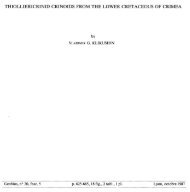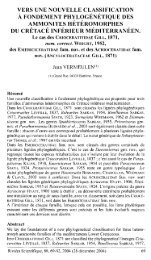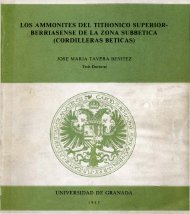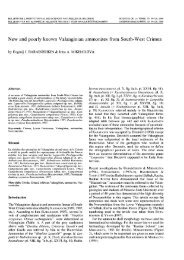peter franklin rawson, dennis curry, frank charles dilley, john michael ...
peter franklin rawson, dennis curry, frank charles dilley, john michael ...
peter franklin rawson, dennis curry, frank charles dilley, john michael ...
You also want an ePaper? Increase the reach of your titles
YUMPU automatically turns print PDFs into web optimized ePapers that Google loves.
Fringing the platform was a deeper water area, the Sole Pit Trough, and itsnorthwestern continuation, the Yorkshire Basin. The Speeton Clay accumulated inthe Yorkshire Basin north of the Market Weighton Hinge. The Wessex (‘Southern’,‘Anglo-Paris’ pars) Basin was an essentially non-marine basin until the Aptian, whenmarine sediments began to accumulate. It maintained intermittent contact with theEast Midlands Shelf by means of a narrow seaway fringing the western margins ofthe Anglo-Brabant Massif.The development of three separate Lower Cretaceous depositional areas accountsfor the rapid fades changes and hence the difficulty of effecting detailed correlation.The difficulty is increased by the fact that marine communication in the areas northof the Anglo-Brabant Massif was with the North Sea region and the Boreal region ingeneral, while the initially more enclosed Wessex Basin opened out to the WesternApproaches and Paris Basins and developed faunal links with France and Spain.However, the series of transgressive phases that started in the Barremian in manyparts of the North Sea continued sporadically during the Aptian and reached highenough levels in the Albian and Cenomanian to produce more uniform depositionover Britain. The Market Weighton Hinge and the Anglo-Brabant Massif weretransgressed during the Albian and the extended area of deposition is now representedby a more or less continuous outcrop from Yorkshire to Dorset. Along thisoutcrop there is a marked change from Red Chalk in the north to Gault Claysouthwards, and from the clay facies of the Gault in the east into arenaceous UpperGreensand westwards.The new onshore depositional pattern was accentuated during late Cretaceoustimes. Chalk sedimentation, initiated in the Cenomanian, continued throughout, theChalk Formation draping former highs and basins with a thick and continuous cover,although the Anglo-Brabant Massif continued to affect thicknesses and facies.Following the Cenomanian transgressive peak there was a strongly regressive phaseduring the Turonian, expressed sedimentologically as repeated horizons of nodularchalk and/or hardgrounds, after which there was a second, even more important,transgressive phase which culminated in the late Campanian: during this secondphase practically the whole of Britain must have been submerged under a considerabledepth of water, with only a few upland areas remaining as islands. In spite of ageneral fall in sea level during the Maastrichtian, transgressive sediments of this ageoccur in and around the North Sea.In the North Sea area, the Cretaceous history was broadly similar. The Mid NorthSea High (Fig. 2) and the Ringk0bing-Fyn High separated the northern and southernsectors of the North Sea from late Palaeozoic times onward, but their role diminishedprogressively during the late Mesozoic until by late Cretaceous times thearea developed into a single basin. The Lower Cretaceous depositional patterncontinued the earlier history of fault control on a broad scale with local modificationof thickness and facies imposed by halokinetic movements, the latter dominating inthe southern North Sea. The Upper Cretaceous marks a transition towards the later,Tertiary, basinal subsidence (Kent 1975b), the widespread Chalk facies blanketingearlier irregularities whilst grading northwards into calcareous shales and silts in the
















